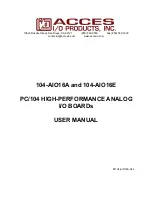
Manual 104-AIO16A and 104-AIO16E
6
A fully programmable 8254 16-bit counter is provided with a maximum input frequency of 10MHz. The
clock and output can be accessed externally for extended functionality.
16 S.E./
8 DIFF'L
A/D DATA FIFO
STATUS
REGISTER
MUX INCREMENT
& CONTROL LOGIC
MUX
VREF
16 S.E.
OR
8 DIFF'L
ANALOG
INPUTS
DATA
BUFFERS
ADDRESS
DECODE
SELECT
&
CONTROL
REGISTERS
INTERRUPT
CONTROL
A/D
TRIGGER
SELECT
LOGIC
{
P
C
1
0
4
B
U
S
A/D START
CH0 HI
CH0 LO
CH15
16
BIT
CTR
0
16
BIT
CTR
1
16
BIT
CTR
2
CTR2
OUT
DUAL 12
BIT DAC
DAC A
DAC B
SIGNAL COND.
INCL CAL ADJ
SIGNAL COND.
INCL CAL ADJ
CONTAINED
IN CPLD
16 BITS
DIGITAL
(2x8-BITS)
INPUT
OUTPUT
{
16 BITS
SIGNAL COND.
INCL CAL ADJ
EEPROM
(CAL DATA)
CTR0
OUT
INTERNAL DATA BUS
10 MHz
16 BIT A/D CONVERTER
(500 KSamples/Second)
CTR0
INPUT
CONTAINED IN 8254
Figure 1-1:
Block Diagram
Analog Inputs
There are a total of 16 single-ended or 8 differential analog inputs on this board. A consecutive set of
channels are enabled/disabled by software. This set of channels is constructed by a start and end
channel. Sampling begins on the start channel and continues through every successive channel until the
end channel is sampled. Once the end channel has been sampled, the process repeats again from the
start channel. All channels within the set are jumper configured as either single-ended or differential.
10 input ranges, 6 bipolar and 4 unipolar, are selectable by software. Each jumper configuration
allows four voltage ranges to be configured by software for each individual channel (Table 1-1). The
unipolar ranges are 0-1V, 0-2V, 0-5V, and 0-10V. The bipolar ranges are ±0.5V, ±1, ±2V, ±2.5V, ±5V,
and ±10V. Refer to the option selection map for jumper range settings.
Each channel input has an over-voltage protection of -40V to +55V.







































